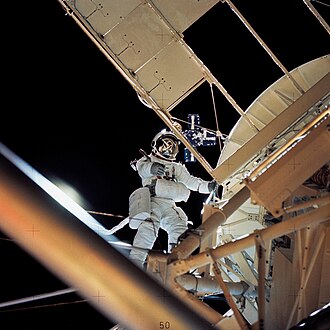Hubble Space Telescope





Hubble Space Telescope
The Hubble Space Telescope (HST) is a space-based observatory that has revolutionized astronomy since its launch on April 24, 1990. Unlike ground-based telescopes, Hubble orbits above Earth's distorting atmosphere, which allows it to capture high-resolution images of astronomical objects with unparalleled clarity. This has made Hubble one of the most important instruments in the history of astronomy, contributing to significant discoveries in various fields such as cosmology, galactic astronomy, and planetary science.
Design and Capabilities[edit]
The Hubble Space Telescope is named after Edwin Hubble, an American astronomer who made pivotal discoveries in extragalactic astronomy. Hubble's design features a 2.4-meter (7.9 ft) primary mirror and five main scientific instruments that observe in the ultraviolet, visible, and near-infrared regions of the electromagnetic spectrum. These instruments include cameras and spectrographs that have been upgraded over the years through servicing missions conducted by NASA astronauts using the Space Shuttle.
Scientific Achievements[edit]
Hubble's contributions to science are numerous and varied. It played a key role in determining the rate of expansion of the Universe, known as the Hubble constant. It has captured detailed images of distant galaxies, providing insights into the structure and evolution of the Universe from shortly after the Big Bang to the present day. Hubble has also studied the atmospheres of exoplanets, observed the processes of star and planet formation within nebulae, and monitored the behavior of objects within our own Solar System, including the impact of Comet Shoemaker-Levy 9 with Jupiter.
Servicing Missions[edit]
Over its lifetime, Hubble has benefited from several servicing missions that have repaired and upgraded its systems and instruments. The most notable of these was the first servicing mission in 1993, which corrected the spherical aberration of the primary mirror. In total, five servicing missions, the last in 2009, have allowed Hubble to continue its scientific contributions beyond its expected lifespan.
Legacy and Future[edit]
The Hubble Space Telescope has had a profound impact on our understanding of the universe. Its images have not only advanced scientific knowledge but have also entered popular culture, inspiring a sense of wonder about the cosmos. The James Webb Space Telescope, launched in December 2021, is considered a successor to Hubble, though Hubble remains in operation and continues to contribute valuable observations. The synergy between Hubble and newer observatories promises to further expand our knowledge of the cosmos.
See Also[edit]

This article is a space- or spaceflight-related stub. You can help WikiMD by expanding it!
Ad. Transform your life with W8MD's Budget GLP-1 injections from $75


W8MD offers a medical weight loss program to lose weight in Philadelphia. Our physician-supervised medical weight loss provides:
- Weight loss injections in NYC (generic and brand names):
- Zepbound / Mounjaro, Wegovy / Ozempic, Saxenda
- Most insurances accepted or discounted self-pay rates. We will obtain insurance prior authorizations if needed.
- Generic GLP1 weight loss injections from $75 for the starting dose.
- Also offer prescription weight loss medications including Phentermine, Qsymia, Diethylpropion, Contrave etc.
NYC weight loss doctor appointmentsNYC weight loss doctor appointments
Start your NYC weight loss journey today at our NYC medical weight loss and Philadelphia medical weight loss clinics.
- Call 718-946-5500 to lose weight in NYC or for medical weight loss in Philadelphia 215-676-2334.
- Tags:NYC medical weight loss, Philadelphia lose weight Zepbound NYC, Budget GLP1 weight loss injections, Wegovy Philadelphia, Wegovy NYC, Philadelphia medical weight loss, Brookly weight loss and Wegovy NYC
|
WikiMD's Wellness Encyclopedia |
| Let Food Be Thy Medicine Medicine Thy Food - Hippocrates |
Medical Disclaimer: WikiMD is not a substitute for professional medical advice. The information on WikiMD is provided as an information resource only, may be incorrect, outdated or misleading, and is not to be used or relied on for any diagnostic or treatment purposes. Please consult your health care provider before making any healthcare decisions or for guidance about a specific medical condition. WikiMD expressly disclaims responsibility, and shall have no liability, for any damages, loss, injury, or liability whatsoever suffered as a result of your reliance on the information contained in this site. By visiting this site you agree to the foregoing terms and conditions, which may from time to time be changed or supplemented by WikiMD. If you do not agree to the foregoing terms and conditions, you should not enter or use this site. See full disclaimer.
Credits:Most images are courtesy of Wikimedia commons, and templates, categories Wikipedia, licensed under CC BY SA or similar.
Translate this page: - East Asian
中文,
日本,
한국어,
South Asian
हिन्दी,
தமிழ்,
తెలుగు,
Urdu,
ಕನ್ನಡ,
Southeast Asian
Indonesian,
Vietnamese,
Thai,
မြန်မာဘာသာ,
বাংলা
European
español,
Deutsch,
français,
Greek,
português do Brasil,
polski,
română,
русский,
Nederlands,
norsk,
svenska,
suomi,
Italian
Middle Eastern & African
عربى,
Turkish,
Persian,
Hebrew,
Afrikaans,
isiZulu,
Kiswahili,
Other
Bulgarian,
Hungarian,
Czech,
Swedish,
മലയാളം,
मराठी,
ਪੰਜਾਬੀ,
ગુજરાતી,
Portuguese,
Ukrainian